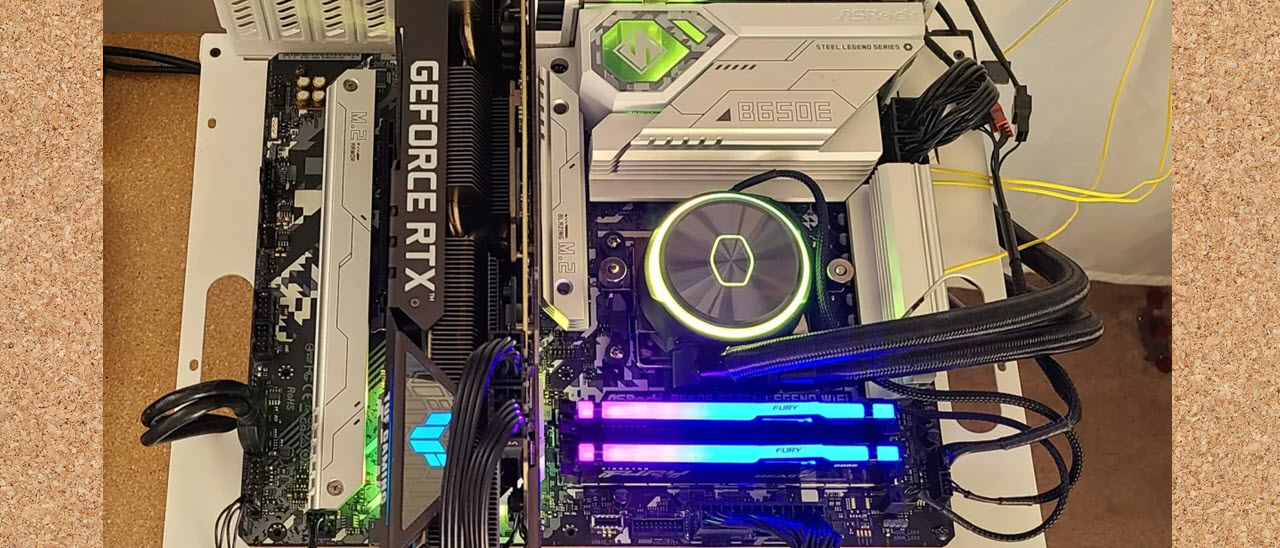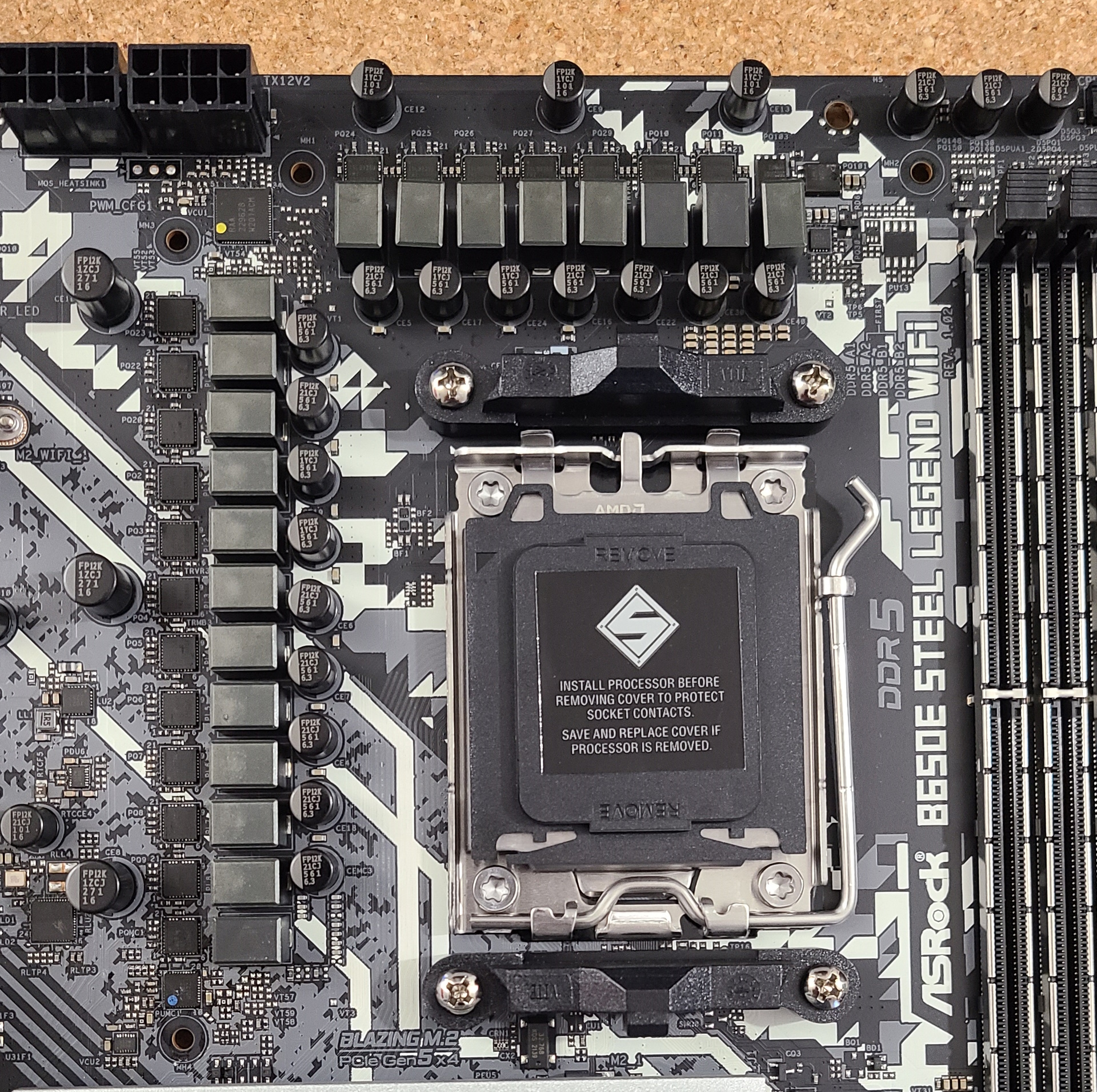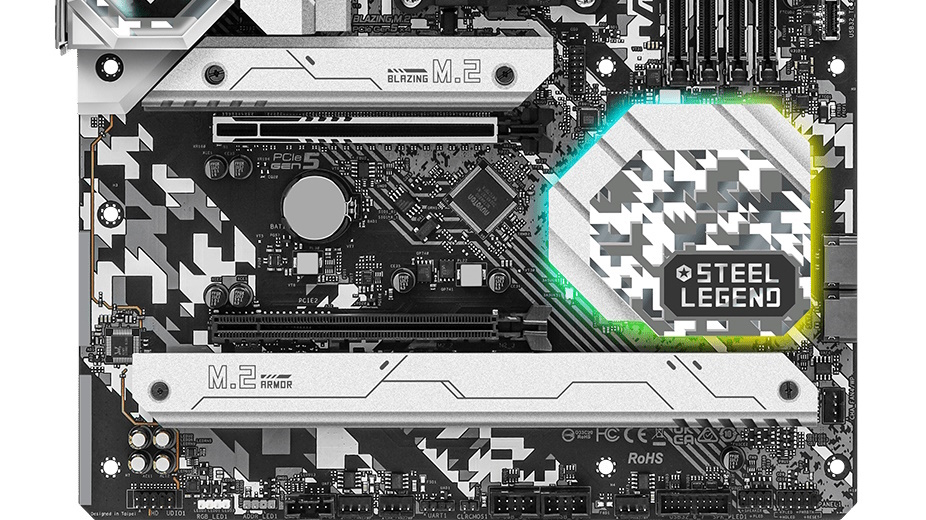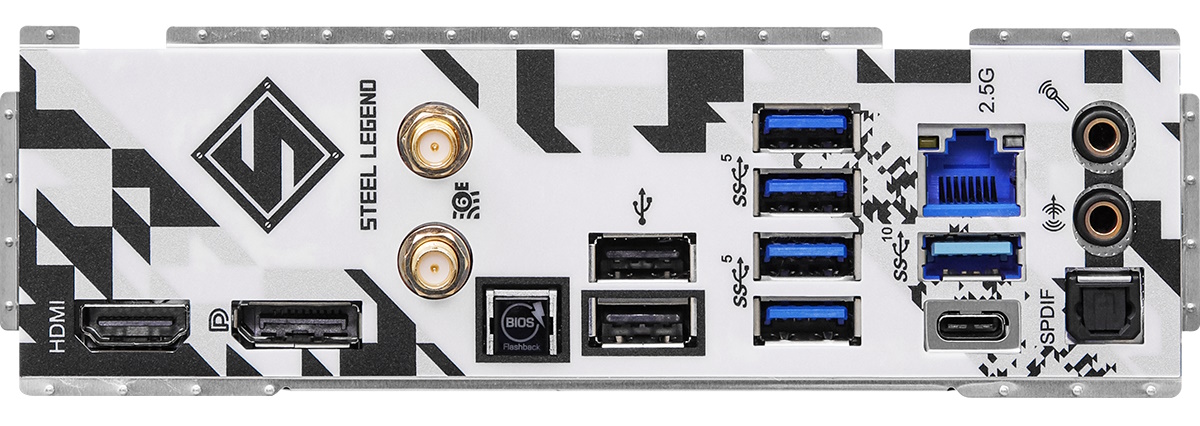Tom's Hardware Verdict
ASRock’s B650E Steel Legend did well in our benchmarking suite and overclocked our Ryzen 9 7950X with ease. It also looks good. But it’s short a couple of SATA ports and we’d prefer an updated audio codec, especially since the $269 price is higher than the competition.
Pros
- +
Unique steel/black theme
Cons
- -
Only two SATA ports
- -
Dated audio codec
- -
No quick release or latches for M.2
Why you can trust Tom's Hardware
ASRock’s B650E Steel Legend Wi-Fi is a mid-range offering in the B650E board realm. Priced at $269.99, it comes with that steely black-on-grey aesthetic, PCIe 5.0 support, capable power delivery, three M.2 sockets (including one 5.0 128 Gbps socket), eight USB ports on the rear IO, and more. While it’s a capable and performant board, it only sports two SATA ports. Even though M.2 drives have come down in price, many people still use more than two SATA-based storage devices. And its audio hardware, while probably fine for most people, is dated compared to the competition.
ASRock’s B650 lineup (at the time of this writing) consists of 10 different motherboards. There you’ll find all the standard sizes and wide-ranging prices, with familiar names like the Taichi, PG Riptide, PG LIghtning, Pro RS, Livemixer, and our Steel Legend SKU. Prices range from $349.99 (Taichi Carrara) to the ASRock B650M PG Riptide at $169.99. There are plenty of options in the existing lineup, including MicroATX and Mini-ITX SKUs.
Regarding performance, our Steel Legend was average to above average across our testing suite. It performed well overall in gaming and elsewhere in our benchmarks. Nothing was too fast, but nothing was inordinately slow, either. With proper cooling, you’ll be able to get the most out of your AMD processor on this board.
Below, we’ll dig into the details of the board and see whether it deserves a spot on our Best Motherboards list. But before we get into our testing and board details, we’ll start by listing the specifications from ASRock’s website.
Specifications: ASRock B650E Steel Legend Wi-Fi
| Socket | AM5 (LGA 1718) |
| Chipset | B650 |
| Form Factor | ATX |
| Voltage Regulator | 19 Phase (16x 60A MOSFETs for Vcore) |
| Video Ports | (1) HDMI (v2.1) |
| (1) DisplayPort (v1.4) | |
| USB Ports | (1) USB 3.2 Gen 2 Type-C (10 Gbps) |
| (1) USB 3.2 Gen 2 (10 Gbps) | |
| (4) USB 3.2 Gen 1 (5 Gbps) | |
| (2) USB 2.0 (480 Mbps) | |
| Network Jacks | (1) 2.5 GbE |
| Audio Jacks | (2) Analog + SPDIF |
| Legacy Ports/Jacks | ✗ |
| Other Ports/Jack | ✗ |
| PCIe x16 | (1) v5.0 (x16) |
| (1) v3.0 (x4) | |
| PCIe x8 | ✗ |
| PCIe x4 | ✗ |
| PCIe x1 | ✗ |
| CrossFire/SLI | AMD CrossFire |
| DIMM Slots | (4) DDR5 6600+(OC), 128GB Capacity |
| M.2 Sockets | (1) PCIe 5.0 x4 (128 Gbps) / PCIe (up to 80mm) |
| (2) PCIe 4.0 x4 (64 Gbps) / PCIe (up to 80mm) | |
| Supports RAID 0/1/5 | |
| SATA Ports | (2) SATA3 6 Gbps (Supports RAID 0/1/5/10) |
| USB Headers | (2) USB v3.2 Gen 1 (5 Gbps) |
| (2) USB v2.0 (480 Mbps) | |
| Fan/Pump Headers | (6) 4-Pin (CPU, CPU/Water Pump, Chassis/water pump) |
| RGB Headers | (3) aRGB (3-pin) |
| (1) RGB (4-pin) | |
| Diagnostics Panel | (1) Post Status Checked (4 LEDs) |
| Internal Button/Switch | ✗ |
| SATA Controllers | ✗ |
| Ethernet Controller(s) | (1) Realtek Dragon RTL8125BG (2.5 GbE) |
| Wi-Fi / Bluetooth | ✗ |
| USB Controllers | ✗ |
| HD Audio Codec | Realtek ALC897 |
| DDL/DTS | ✗ / ✗ |
| Warranty | 3 Years |
Inside the Box of the ASRock B650E Steel Legend Wi-Fi
Inside the retail packaging, below the motherboard, are a few accessories to help get you started. You get two SATA cables, screws/standoffs for M.2, the Wi-Fi antenna and the user manual. ASRock also includes a graphics card holder that attaches to the motherboard to support those heavy video cards. Like the Z790 Livemixer’s accessory stack, there isn’t much here. In fact, we just listed everything in the box.
Design of the ASRock B650E Steel Legend Wi-Fi
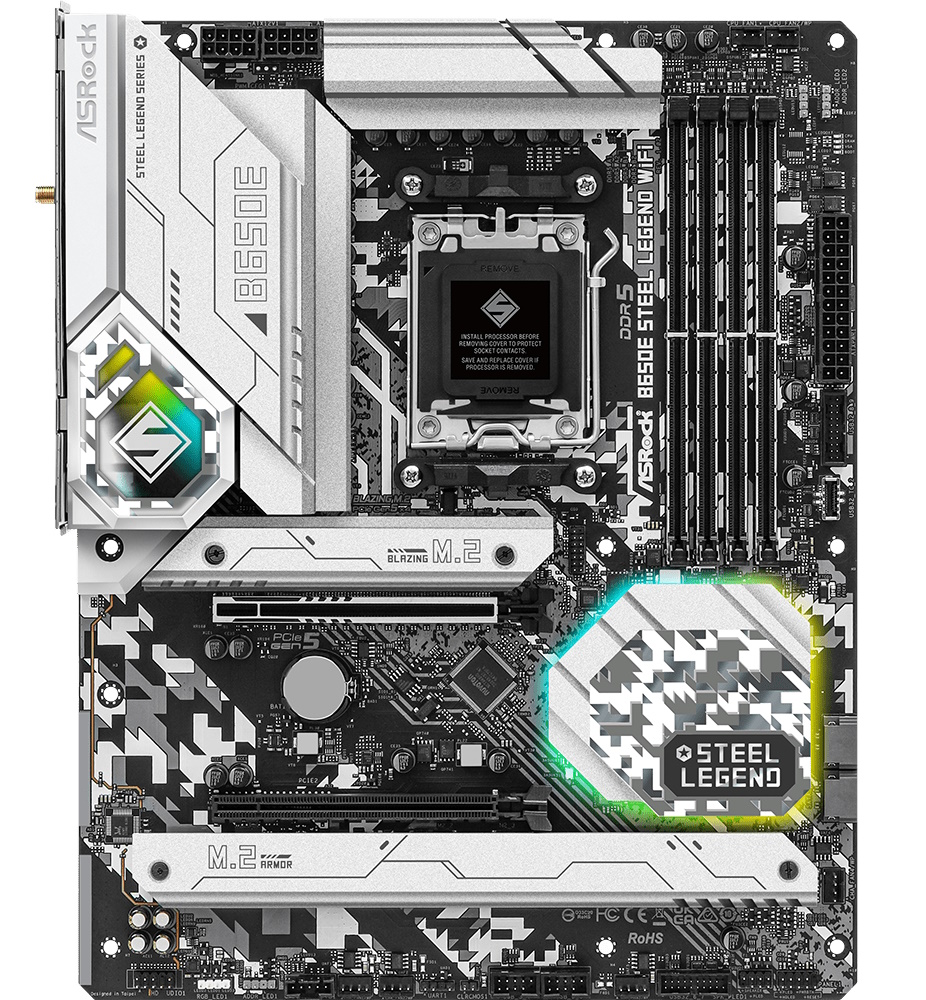
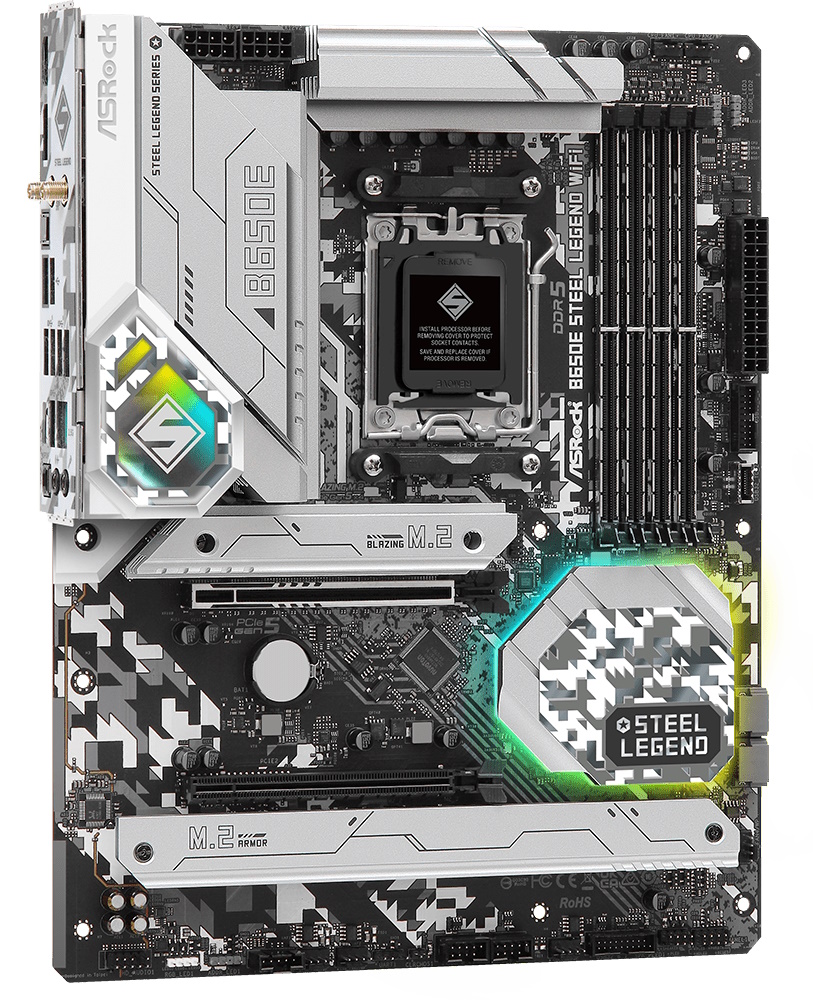
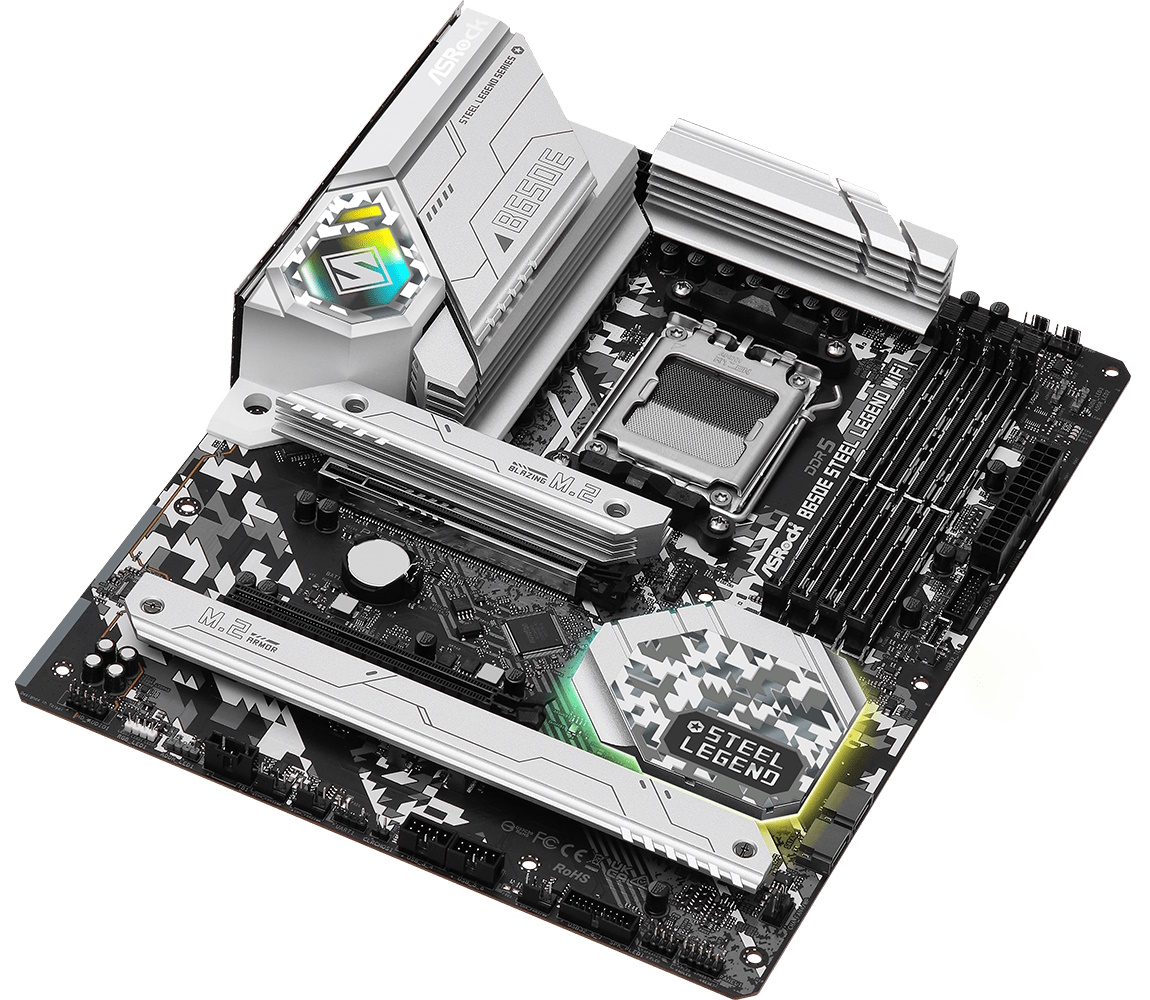
ASRock describes the Steel Legend as a “philosophical state of rock-solid durability and irresistible aesthetics.” Aimed at daily users and mainstream enthusiasts, you won’t find any LED screens or a fully covered board, but there are ‘steel’ colored heatsinks on top of an 8-layer, black PCB. The motherboard also has camo-like black white and grey patterns around the socket, audio area, and the chipset.
The VRM heatsinks and shroud to the left of the socket house RGB LEDs that light up the “S” symbol for the Steel Legend. You’ll find additional RGBs under the chipset heatsink, while a large heatsink sits on top of the PCI 5.0 M.2 socket and another covers the other two M.2 sockets across the bottom of the board. Overall, this is a good-looking mid-range B650E board.
Get Tom's Hardware's best news and in-depth reviews, straight to your inbox.
In the upper-left corner, the VRM heatsink sports the ASRock branding in white, along with the Steel Legend Series and B650E stenciled on the heatsink / shroud. The RGBs here (and on the chipset heatsink) are bright and saturated, so they will do a good job illuminating the inside of your chassis. The VRM heatsink isn’t as big as others, but it does the job well. Above the VRM heatsinks are two 8-pin EPS connectors (one required) that power the processor.
To the right of the camo-like pattern around the socket area, we run into four reinforced DRAM slots with the locking mechanism on the top. Supporting up to 128GB of DDR5, the Steel Legend supports speeds up to DDR5-6600+(OC), but your mileage may vary. Our DDR5-5600 and DDR5-6000 kits worked without issue during testing.
Above the DRAM slots are the first two (of six) four-pin fan headers. The CPU_FAN1 supports fan power up to 1A/12W, while the rest of the headers (CPU_FAN2/WP, CHA_FAN1~4/WP) support up to 2A/24W fan power. There are enough of these headers to run most, if not all, of your fans from the motherboard. The BIOS or ASRock’s A-Tune application controls these headers.
Moving down the right edge, we find the first two (of four) RGB headers. In this area are two 3-pin ARGB headers, while on the bottom of the board are additional 3-pin ARGB and 4-pin RGB headers. Just below these is the Post Status Checker. Four LEDs light up during the POST process if there is a problem with DRAM, CPU, Boot device, or VGA. Next is the 24-pin EPS connector to power the board, a front panel USB 3.2 Gen 1 (5 Gbps) connector and the front panel USB 3.2 Gen 2x2 (20 Gbps) header. There are only eight USB ports on the rear IO, so some users may really need the additional headers/ports it offers.
The VRMs on the B650E Legend consist of 19 total phases, with 16 dedicated to Vcore. Power feeds from the 8-pin EPS connectors down to the Renesas RAA229628 20-phase PWM controller, then moves to the 16x 60A Intersil ISL99360 SPS MOSFETs. The 960A available certainly isn’t the most powerful we’ve seen, but it handled our flagship Ryzen 9 7950X flagship without concern.
The audio section is hidden a bit among the stenciling on the left side of the PCB. The ever-present audio separation line is visible, running from the bottom of the board to the top M.2 socket, along with the dated Realtek ALC897 codec. You won’t find any third-party DACs or Amps at this price, so if you’re a critical listener or have a decent set of cans / speakers, you’ll want an external solution for the best results. Most others likely won’t notice the dated codec used here.
In the middle of the board are two full-length PCIe slots and three M.2 sockets. The top PCIe socket under the large heatsink connects through the CPU and runs at PCIe 5.0 x16 speeds. The bottom socket sources its lanes from the chipset, running at PCIe 3.0 x4 speeds. The board lists AMD Crossfire support, if you’re still into that sort of thing.
The top M.2 socket sits above the primary PCIe slot and gets its lanes from the CPU, running at PCIe 5.0 x4 (128 Gbps) speeds while supporting up to 80mm modules. The bottom two sockets are under a smaller (by mass) heatsink below the bottom PCIe slot. Each socket supports up to 80mm PCIe 4.0 x4 drives. With this configuration, there isn’t any sharing of ports or bandwidth, so what you see is what you get!
Moving past the illuminated chipset heatsink to the right edge, we find two SATA ports. In fact, these are the only two SATA ports on the board, which could be a problem for quite a few users looking to carry over older drives. Worst case: You can add more via a roughly $40 add-in-card, but I’d still like to see at least four ports here, especially on more budget-oriented models where M.2 drives may not be as common SATA-based SSD or HDDs.
Across the bottom of the board are several exposed headers. You’ll find the usual, including additional USB ports, RGB headers, and power/reset buttons. Below is a complete list, from left to right.
- Front panel audio
- 4-pin ARGB header
- 3-pin ARGB header
- 5-pin Thunderbolt AIC connector
- (2) System Fan headers
- Clear CMOS jumper
- (2) USB 2.0 headers
- System fan header
- USB 3.2 Gen 1 connector
- Speaker header
- System panel header
The rear IO plate on the B650E Steel Legend, like many others, comes preinstalled to the motherboard. It sports the same black, white and grey background against black labels, along with the Steel Series ‘S’ branding. There are eight total USB slots on the rear IO. You get two USB 3.2 Gen 2 (10 Gbps) Type-C and Type-A ports, four USB 3.2 Gen 1 (5 Gbps) Type-A ports, and two USB 2.0 ports. Video outputs consist of one HDMI and DisplayPort. You’ll also find the Wi-FI antenna connections for the integrated Wi-Fi 6E, a BIOS flashback button, the Realtek Dragon-based 2.5 GbE port, and last but not least, the dual analog plus SPDIF audio stack.
MORE: Best Motherboards
MORE: How To Choose A Motherboard
MORE: All Motherboard Content

Joe Shields is a staff writer at Tom’s Hardware. He reviews motherboards and PC components.
-
CircuitJammer Honestly, SATA is on its way out. Two ports is probably sufficient for 99% of users. If you need more, buy something else.Reply -
helper800 Reply
I would personally not mind only 2-4 sata ports as long as I have 3+ m.2 slots.CircuitJammer said:Honestly, SATA is on its way out. Two ports is probably sufficient for 99% of users. If you need more, buy something else. -
PiranhaTech If it's that high of price and they want to reduce the ports, they should start integrating the likes of SAS ports into the boards. Each SAS port is easily expanded to 4 SATA devicesReply
I forgot what the other drive tech was. -
PlaneInTheSky Only 2 SATA ports, wtf.Reply
Still using USB 2.0 ports for both the back and board.
Only 1 USB-C port.
2.5Gbit/s instead of 10Gbit/s.
Ancient audio codecs.
And you want how much for this?!
No thanks. -
PlaneInTheSky ReplyHonestly, SATA is on its way out. Two ports is probably sufficient for 99% of users.
You are being ridiculous. Blu-Ray players and HDD still use SATA, and that isn't going to change any times soon.
Maybe you never back-up anything on your PC, but plenty of people do, and most people use HDD for that. HDD that use SATA.
Having only 2 SATA ports makes this board a no-go for anyone doing back-ups and using optical media.
And if you never do any serious work on your PC that requires a back-up, then why are you on TomsHardware or use a PC. Buy a console and chromebook instead. -
Gavin Greenwalt ReplyPlaneInTheSky said:You are being ridiculous. Blu-Ray players and HDD still use SATA, and that isn't going to change any times soon.
Ok... So one HDD on SATA and one Blu-ray drive on the other SATA done.
Most people backup to external drives these days anyway. Also optical drives are rare.
Also... Also... Optical for backup?? At 50GB per disk? Even a full spindle of 50 blurays is 2.5TB. You could get a small external 4TB HDD for $80 vs a 100 disc spindle of Blurays for $150.
The HDD is more compact and cheaper. You could (and should) but two USB drives and off-site one of them to a friend's house for the price of Blurays which also aren't rated for archival.
Or you could get like 2-3 years of cloud storage.
And for the handful of people living in the age of Limp Biskit and other 2000s nostalgia there are m.2 SAS cards with 8x SATA ports and you can go crazy without even using a single pcie slot. -
PlaneInTheSky ReplyYou could (and should) buy two USB drives and off-site one of them to a friend's house
Proper back-up is done with RAID.
Not some USB drive you attach on a sunday afternoon, while losing half your data from the week. -
adrian84481 I don't see anything wrong with the price or specs here. Seriously, it's a 4x DDR5 mobo, with PICe5.0 M.2 (and an additional 2x M.2 slots), decent VRM setup, decent connectivity (USB3.2 and WiFi 6E). Of course price is going to be high (AM5/DDR5, duh!). Complaining about "only" 2x SATA ports in 2023 is a bit of a stretch. 2x SATA is more than enough nowadays, you can still have one SATA SSD and one optical drive (because not all of us have coin to spend on large M.2 SSDs), or a "backup" HDD and an optical drive (yes, quotes around "backup", as a proper backup is stored off-machine, because, you know, crypto lockers and data corruption due to various reasons and physical theft and stuff).Reply
